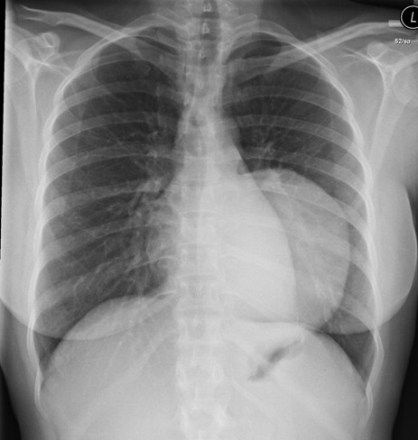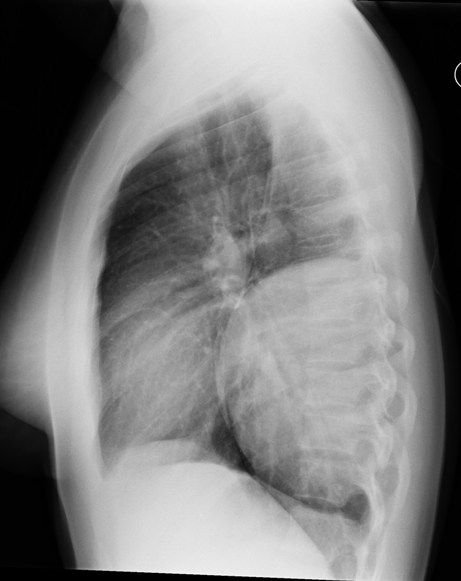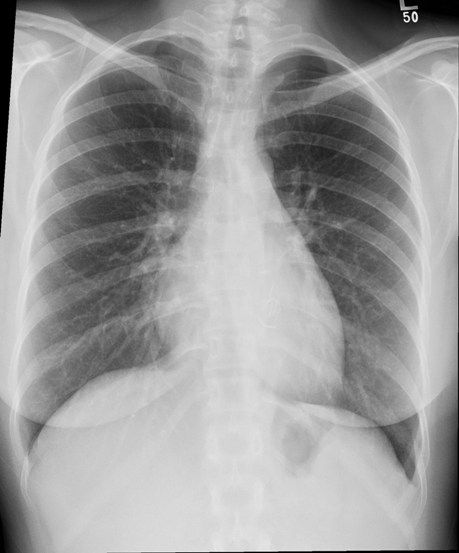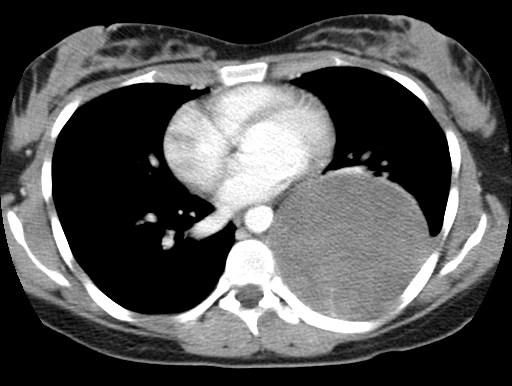Asymptomatic Thoracic Schwannoma
On routine chest screening X-ray, a 25-year-old, asymptomatic, female patient found to have well-defined, rounded soft tissue opacity in left lower thoracic para spinal region.
History
On routine chest screening X-ray, a 25-year-old, asymptomatic, female patient found to have well-defined, rounded soft tissue opacity in left lower thoracic para spinal region. There was no obvious bone involvement.




A CT scan with contrast done for better evaluation and confirmation. The CT showed well circumscribed heterogeneously enhancing lesion in left lower thoracic para spinal mass with no calcifications,no bony or spinal canal involvement.


Thoracic surgery for complete removal of mass was performed and pathology showed Schwannoma.
Follow-up film after operation was normal.
Diagnosis
Thoracic schwannoma
Discussion
Schwannoma is the most common nerve sheath tumor in the posterior mediastinum. The majority of patients with this type of tumor are asymptomatic. Up to 11.7 percent of patients have been reported to be symptomatic based on the size and location of the tumor
Neurogenic tumors are the most common cause of a mass lesion in the thoracic paravertebral region in the general adult population. Schwannomas are rare in people <20 years of age and are largely asymptomatic.On gross pathologic analysis, they appear as sharply circumscribed, spherical soft-tissue masses.They are eccentric and encapsulated and do not have nerve fibers passing through them.
There are no plain-film findings that are pathognomonic for intrathoracic schwannomas. Chest radiography usually shows a smoothly rounded or oval mass located in the paravertebral region. The mass is rarely calcified, and inferior and superior sulci are usually present.While bone changes on plain films are generally late manifestations of schwannomas.There are some findings that can help narrow the differential diagnosis. Bone changes, such as erosion or splaying of the ribs, may occur as well as neural foraminal enlargement and vertebral body erosion.Rib erosion with a sclerotic border is suggestive of a benign lesion; however, spreading to multiple ribs with erosion suggests malignancy.
Schwannomas appear as well-circumscribed, round masses that are of homogenous soft-tissue density on plain CT images, with clear preservation of surrounding fat planes. The attenuation values of schwannomas tend to be lower than those of the surrounding muscle, which may be accounted for by their areas of low cellularity. Schwannomas may occasionally be seen as areas of very low attenuation on noncontrast CT exams if there is a high concentration of lipid-rich Schwann cells in these tumors. Schwannomas have even been described as presenting as cystic masses. Schwannomas show variable enhancement on contrast-enhanced CT scans. The heterogeneity is due to cystic degeneration, xanthomatous change, variabilities in hyper- and hypocellular areas, and areas of hemorrhage. A pattern of rim enhancement has also been described.Malignant schwannomas have CT findings of low-density areas, compression of adjacent structures, pleural abnormalities, such as pleural effusions or pleural nodules, and metastatic pulmonary nodules.
In the more usual nonemergency setting, MRI is the preferred modality for imaging neurogenic tumors, as its multiplanar capability and high soft-tissue contrast resolution can best reveal the nature of lesions, intraspinal extension, and cranial-caudal extent. More specifically, MRI is more sensitive than CT for the identification of schwannoma. On MRI, schwannomas show low-to-intermediate signal intensity on T1-weighted images. On T2-weighted images, they show inhomogenously high intensity. Very high intensity regions seen on T2-weighted images of schwannomas correspond to cystic degeneration with surrounding collagenous fibrous tissue.
On MRI with gadolinium contrast, there will be dense enhancement of the tumor that will be heterogeneous if large and homogeneous if small. Most schwannomas have mild-to-markedly increased signal intensity on proton-density and T2-weighted sequences. Schwannomas do not always demonstrate the target appearance often associated with benign neurofibromas.]
There is little in the literature regarding the angiographic findings of extracranial schwannomas. This may be because angiography is used only in cases in which a highly vascular lesion is suspected, critical adjacent arterial structures need to be assessed prior to surgery, or when preoperative embolization is planne In general, schwannomas are largely avascular or hypovascular lesions that are identified by focal displacement,stretching, and draping of adjacent vessels.
1. Reed JC, Hallet KK, Feigin DS. Neural tumors of the thorax: Subject review from the AFIP. Radiology.1978;126:9-17.
2. Osborn AG. Diagnostic Neuroradiology. St. Louis: Mosby Inc;1994.
3. Yamaguchi M, Yoshino I, Fukuyama S, et al. Surgical treatment of neurogenic tumors of the chest Ann Thorac Cardiovasc Surg 2004;10:148-151.[Medline]
Clarius Mobile Health Unveils Anterior Knee Feature for Handheld Ultrasound
April 23rd 2025The T-Mode Anterior Knee feature reportedly offers a combination of automated segmentation and real-time conversion of grayscale ultrasound images into color-coded visuals that bolster understanding for novice ultrasound users.
The Reading Room Podcast: Current Perspectives on the Updated Appropriate Use Criteria for Brain PET
March 18th 2025In a new podcast, Satoshi Minoshima, M.D., Ph.D., and James Williams, Ph.D., share their insights on the recently updated appropriate use criteria for amyloid PET and tau PET in patients with mild cognitive impairment.
What is the Best Use of AI in CT Lung Cancer Screening?
April 18th 2025In comparison to radiologist assessment, the use of AI to pre-screen patients with low-dose CT lung cancer screening provided a 12 percent reduction in mean interpretation time with a slight increase in specificity and a slight decrease in the recall rate, according to new research.